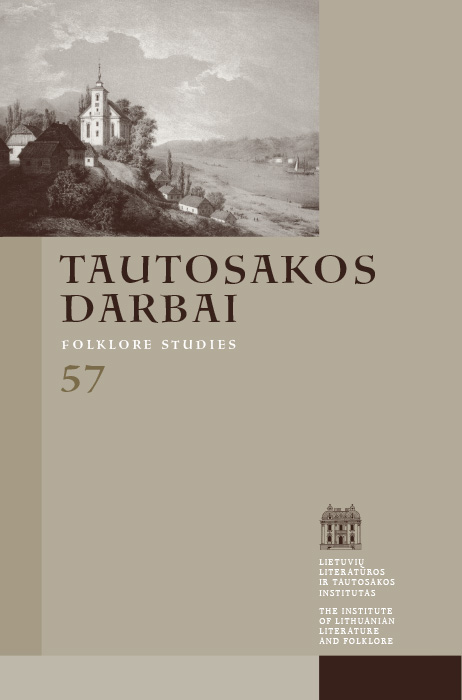Prototypes and Change of the Ornamental Motifs Decorating the Textile Pockets from the Lithuania Minor
Abstract
The historical attire of women from the Lithuania Minor (Klaipėda Region) has a characteristic practical detail: a textile pocket tied at the waist, which functionally corresponds to the modern handbag or pocket. Such textile pockets are called delmonai (pl.) and are usually decorated with colorful ornaments. The purpose of this article is introducing the prototypes of the ornamental motifs in terms of intercultural comparison, employing the visual materials collected by the author and historically formed intercultural contacts. While introducing her hypothesis of possible long-term influences, the author presents décor samples from identical or related textile pockets (from the 17th century until the middle of the 20th century), discussing the possibilities of their finding way to the Lithuania Minor. Researching the change occurring in the décor motifs, the author employs comparative analysis of the traditional (from the beginning of the 19th century until 1930s) and modern (from the beginning of the 21st century) textile pockets, still used as part of the national costume of the Lithuania Minor. The origins of several decorative motifs, e.g. the wreath, the crowned musical instrument, and the flower bouquet, are analyzed in more detail.
The vegetal ornaments predominate in the décor of the textile pockets from the Lithuania Minor, including blossoms, branches, bouquets, leafs, wreaths and stylized trees. Certain modes of representation have been appropriated by the folk art from professional art or textiles. The most important centers of high fashion emerging in France, Italy, and Germany, exercised certain impact on tendencies occurring in the folk handicraft. Examples of textile pockets worn by the nobility were widely promoted by the periodicals. The surviving samples of embroidery patterns indicate one of the possible sources for the textile pockets’ décor in the Lithuania Minor: namely, the printed sheets with ornamental patterns, used by the nobility and lower social classes alike. Another likely source would be functionally similar needlework by women from the neighboring countries, since textile pockets make part of the national costume there as well. Sea trade created favorable conditions for commercial and cultural interchange between neighbors. The motif of wreath, rather frequently used in the Lithuania Minor, and the occasional motif of the flower bouquet also occur on textile pockets from Pomerania (the border region between Poland and Germany). Ornamentation of the pockets from Bavaria (in Germany) is also rather close in character to the décor of the Lithuania Minor. Such congruities may be determined by several reasons. Firstly, the producers of these textile works could have had interconnections (after the onslaught of devastating plague in Europe, numerous people from Salzburg moved to the fertile but rather wasted out territories of the Lithuania Minor). Secondly, the producers could have used the same original pattern, e.g. the printed sheet. However, although the mutual influence in the needlework décor of the neighboring countries determined by their economic and cultural connections is obvious, the décor of the textile pockets from the Lithuania Minor stands out in terms of its peculiar features (particular colors, modes of décor, etc.).
In terms of spreading the regional ethnic culture, the problem of preserving the regional character of the folk art acquires special significance. Although separate parts of the national costumes inevitably change as result of the technical innovations increasingly applied to their production, these costumes should still remain recognizable as a continuation of the folk attire characteristic to the particular region. The patterns of décor used while making the textile pockets nowadays follow to some extent the traditional motifs of floral compositions. Although individual authors tend to create their original compositions, the majority of the textile pockets produced as part of the national costume of the Lithuania Minor still are easily recognizable as belonging to this particular region. The ornamental motifs are not especially distanced from the original ones as well, with embroidered flower bouquets and wreaths still making the majority. However, the motifs of the bouquet placed in a bag and the crowned musical instrument have lost their popularity. Rather than just making part of the national costume of the Lithuania Minor, the textile pockets increasingly appear as part of the modern clothing characterizing its regional peculiarity.
Downloads
Most read articles in this journal
- Lina Būgienė, Foreword , Tautosakos darbai: Vol. 49 (2015)
- Bronė Stundžienė, Foreword , Tautosakos darbai: Vol. 50 (2015)
- Bronė Stundžienė, Our Contributors , Tautosakos darbai: Vol. 62 (2021)
- Bronė Stundžienė, Table of Contents , Tautosakos darbai: Vol. 62 (2021)
- Bronė Stundžienė, Editorial Board , Tautosakos darbai: Vol. 61 (2021)
- Bronė Stundžienė, Our Contributors , Tautosakos darbai: Vol. 48 (2014)
- Aušra Žičkienė, Foreword , Tautosakos darbai: Vol. 54 (2017)
- Bronė Stundžienė, Editorial Board , Tautosakos darbai: Vol. 62 (2021)
- Bronė Stundžienė, Our Contributors , Tautosakos darbai: Vol. 50 (2015)
- Lina Petrošienė, Spontaneous Marginal Songwriting without Borders , Tautosakos darbai: Vol. 60 (2020)




